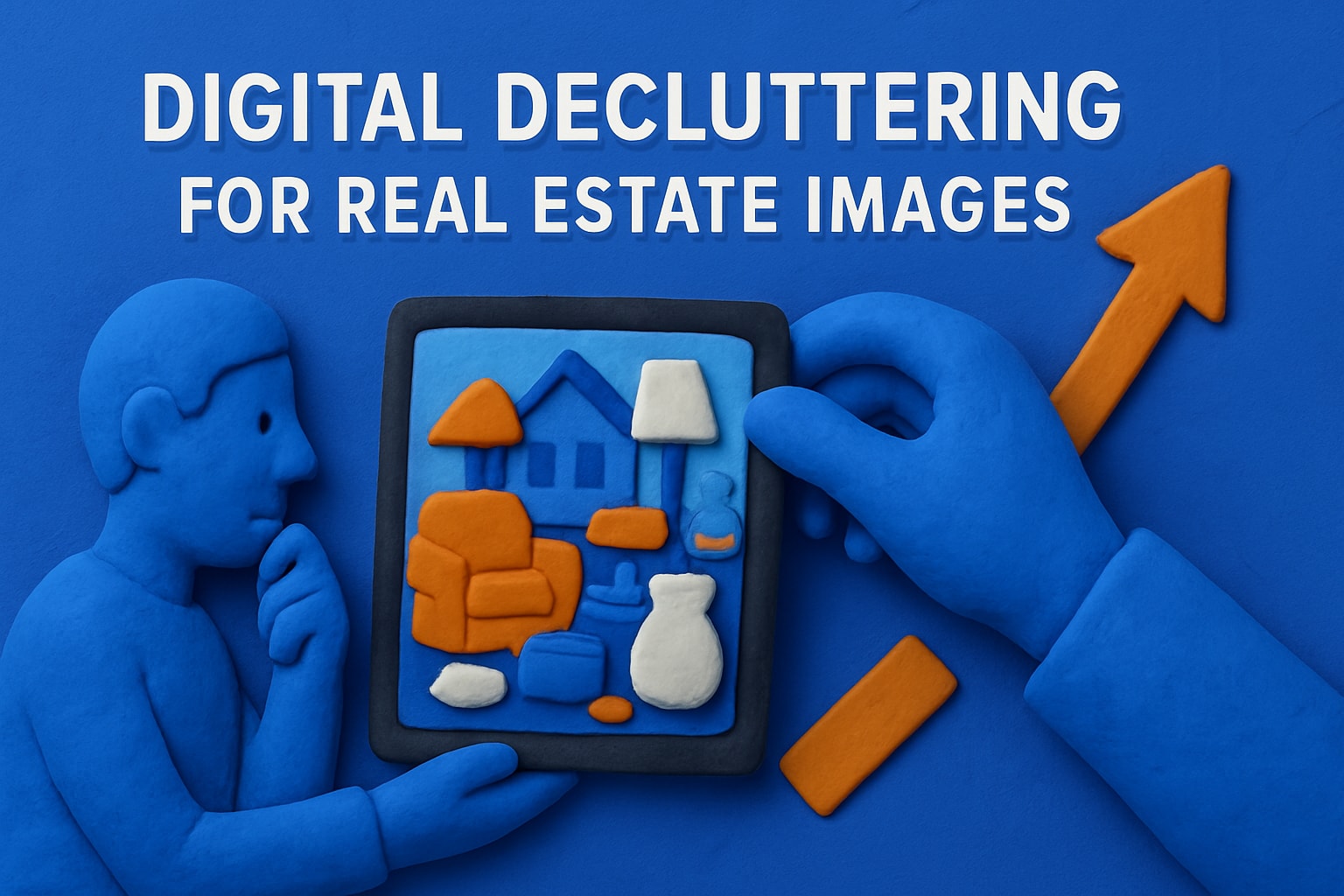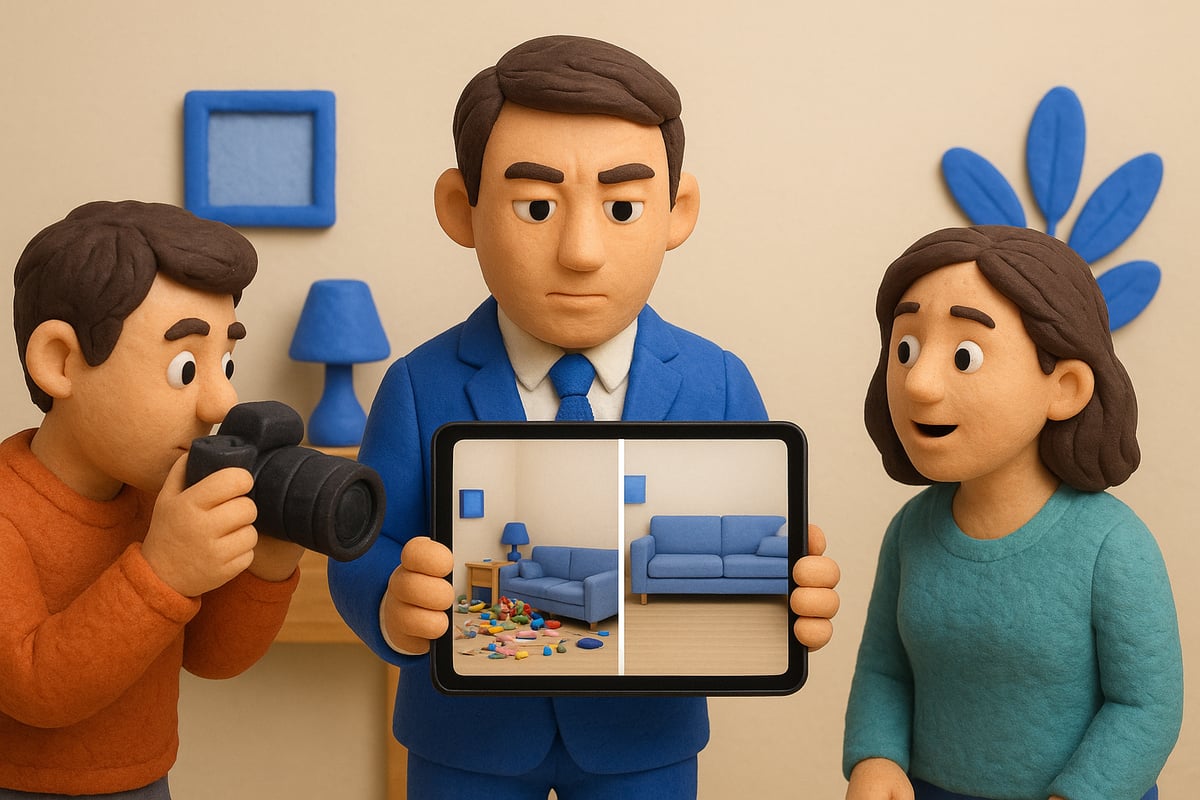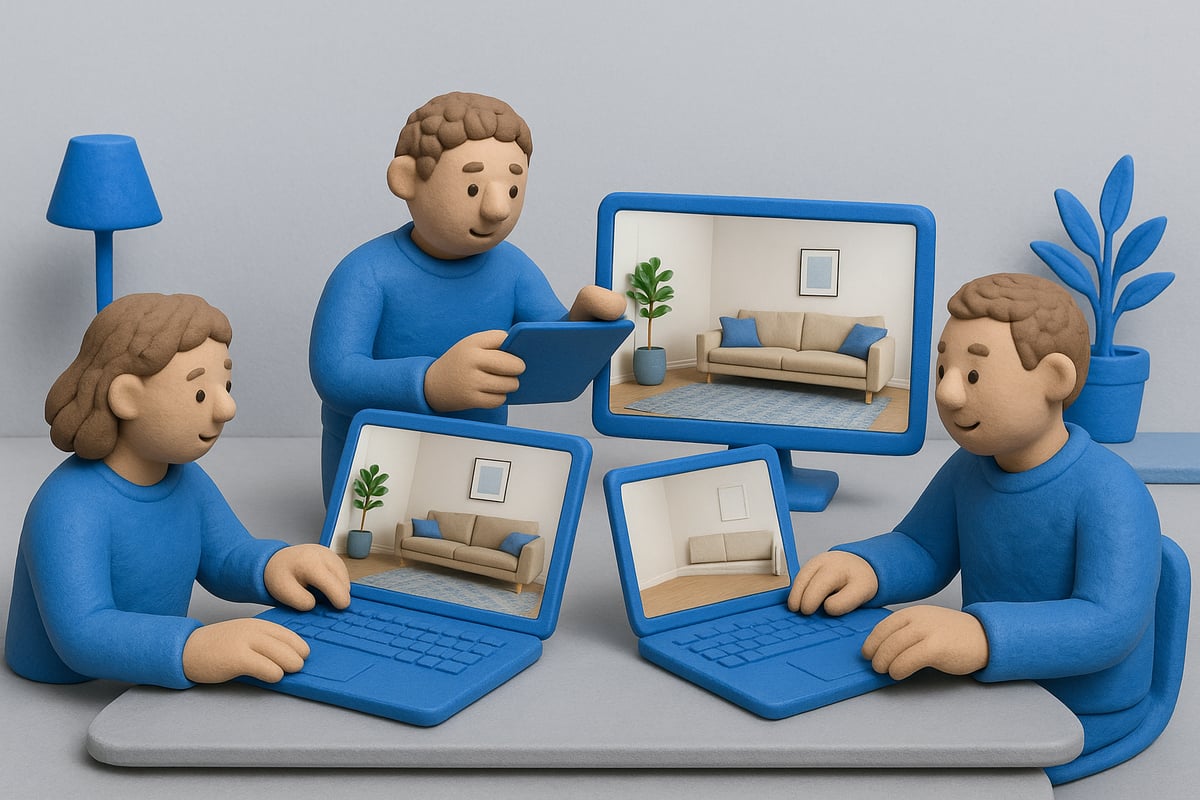Oct 28, 2025
Digital Decluttering for Real Estate Images: The 2025 Guide

Picture a buyer scrolling through endless listings, only to skip yours because cluttered photos hide the home’s best features. In today’s competitive market, first impressions happen in seconds.
Digital decluttering for real estate images is now an essential strategy. Buyers expect clear, inviting visuals that make it easy to imagine themselves in the space.
This 2025 guide shows how digital decluttering transforms property photos. Discover the impact of cluttered images, the benefits of digital solutions, the latest AI tools, and a proven workflow for agents and photographers.
Ready to boost your listings? Let’s explore how to create standout images that attract and engage modern buyers.
The Impact of Cluttered Real Estate Images in 2025
In today’s competitive housing market, buyers form instant opinions based on what they see online. Cluttered, distracting images can quickly turn potential buyers away, making it nearly impossible for them to imagine themselves in a space. According to recent surveys, 85% of buyers say that property photos are the most important factor in deciding which homes to visit. This underscores why digital decluttering for real estate images has become a crucial part of successful marketing strategies.

First impressions are powerful in real estate. Visual clutter in photos distracts buyers from a property’s best features and can lower the perceived value of the home. When buyers cannot see clear countertops or open living spaces, they may assume the property is not well cared for or lacks potential. The psychology behind this is simple: people are drawn to images that feel organized and inviting. Digital decluttering for real estate images helps ensure every room looks its best, allowing buyers to focus on layout and features rather than distractions.
Today’s home searches are overwhelmingly mobile-first. In 2025, nearly 70% of buyers start their property search on smartphones or tablets. On these smaller screens, clutter is magnified, making it even harder for buyers to see the property’s qualities. Listings featuring digital decluttering for real estate images are proven to stand out. Case studies reveal that homes with decluttered photos sell 32% faster on average than those with messy or overcrowded visuals. Before-and-after comparisons consistently show that tidy, digitally enhanced spaces attract more clicks and longer viewing times.
The shift from physical to digital decluttering is transforming how agents and photographers prepare homes for listings. Physically removing clutter can be time-consuming and expensive, especially for lived-in or occupied properties. Digital decluttering for real estate images, by contrast, is faster, more cost-effective, and scalable for any listing. Agents often face challenges such as limited time for staging or uncooperative sellers. With digital solutions, they can address clutter issues after the shoot, ensuring every photo meets high standards without rescheduling or additional expenses.
Industry leaders and recent market surveys highlight the growing importance of image quality in real estate. According to Impact of Photos on Property Perception, high-quality, decluttered images significantly boost buyer engagement and interest. Top-performing agents now rely on digital decluttering for real estate images to maintain a competitive edge, reporting increased inquiries and faster sales cycles. As the expectations of buyers evolve, clean and appealing visuals are no longer optional—they are essential for success in 2025.
Digital Decluttering Explained: What, Why, and How
Digital decluttering for real estate images is a transformative process that removes visual distractions from listing photos, revealing the true potential of a property. In today's competitive market, buyers expect every image to be crisp, clean, and inviting. Digital decluttering for real estate images helps agents and photographers present homes in their best light, creating an immediate positive impression.

What Is Digital Decluttering for Real Estate Images?
Digital decluttering for real estate images refers to the use of advanced software and AI tools to erase unwanted items from property photos. This includes removing excess furniture, personal belongings, and any visual clutter that distracts buyers from the core features of the home. By streamlining the visual presentation, digital decluttering for real estate images delivers clean, inviting photos that resonate with modern buyers.
This process is not about altering the fundamental structure of a space. Instead, it focuses on enhancing clarity and emphasizing the property's best attributes. For agents and photographers, digital decluttering for real estate images is now a standard part of the pre-listing workflow.
The Key Benefits of Digital Decluttering
The advantages of digital decluttering for real estate images are substantial. First, it increases the visual appeal of every room, making listings more attractive and memorable. Properties with digitally decluttered photos tend to generate more buyer interest and receive higher engagement rates online.
Additionally, digital decluttering for real estate images boosts the perceived value of a property. Clean images help buyers imagine themselves living in the space, reducing mental barriers. Faster sales and increased inquiries often follow, as decluttered visuals encourage more showings and stronger offers.
Digital Decluttering vs. Traditional Staging
When comparing digital decluttering for real estate images to traditional physical staging, several differences stand out. Digital methods are faster, more cost-effective, and highly flexible. While traditional staging requires moving or renting furniture, digital decluttering for real estate images achieves similar results with a few clicks.
A quick comparison:
| Feature | Digital Decluttering | Traditional Staging |
|---|---|---|
| Speed | Hours | Days to weeks |
| Cost | Low to moderate | High |
| Flexibility | Easily reversible | Labor intensive |
| Scalability | High | Limited |
Agents no longer need to schedule costly staging appointments, as digital decluttering for real estate images can be done remotely and at scale.
Popular Use Cases for Digital Decluttering
Digital decluttering for real estate images excels in a range of scenarios. For vacant homes, it eliminates leftover items and highlights spaciousness. In lived-in properties, it removes personal effects, creating a neutral canvas for buyers.
Virtual renovations are another powerful use case. Digital decluttering for real estate images can refresh outdated rooms, update décor, or even simulate minor repairs—all without physical changes. This flexibility opens new marketing opportunities for every listing.
Legal and Ethical Considerations
While digital decluttering for real estate images offers many advantages, agents must navigate legal and ethical guidelines. Accurate representation is key. It is essential to disclose if significant items have been removed or altered, ensuring buyers are not misled.
MLS rules and advertising standards often require transparency about digital edits. Agents should always follow best practices and consult with their brokerage or legal counsel if in doubt.
Common Digital Decluttering Techniques
Several techniques define digital decluttering for real estate images. The most common include removing personal items, clearing countertops, erasing excess furniture, and cleaning up backgrounds. Advanced tools can even adjust lighting and color to create a cohesive look.
For a deeper dive into these editing methods, the Real estate photo editing guide provides practical tips and workflow strategies for agents and photographers.
Real-World Examples and Industry Data
Success stories illustrate the power of digital decluttering for real estate images. Listings with digitally enhanced photos sell faster and often at higher prices. According to competitor analysis, 90% of top-performing listings now use some form of digital decluttering for real estate images.
Before-and-after comparisons consistently show dramatic improvements in buyer engagement and property perception. As the industry evolves, digital decluttering for real estate images is set to become not just a trend, but a fundamental standard in real estate marketing.
The Best Tools and AI Solutions for Digital Decluttering in 2025
Digital decluttering for real estate images has become a game changer for agents and photographers aiming to present properties at their best. In 2025, the right tools and AI solutions can dramatically improve efficiency, reduce costs, and enhance the appeal of listings. Below, we explore the leading platforms, compare manual and automated workflows, and outline practical steps for integrating these solutions into your daily process.

Leading AI Image Editing Platforms
The landscape for digital decluttering for real estate images is rapidly evolving. Today’s AI-powered platforms deliver impressive results, making it easier than ever to present spotless, inviting spaces.
Several tools stand out in 2025 for their object removal, virtual staging, and batch processing capabilities. Platforms such as BoxBrownie, Phixer, and Weezard offer intuitive interfaces, cloud-based processing, and quick turnaround times. For example, object removal from real estate photos is now handled in minutes rather than hours.
| Platform | Key Features | Pricing Model | Turnaround Time |
|---|---|---|---|
| BoxBrownie | Object removal, virtual staging | Per image | 24 hours |
| Phixer | Batch edits, AI decluttering | Subscription | 12-24 hours |
| Weezard | AI object removal, cloud editing | Per image/bundle | 1-6 hours |
Agents report that these tools cut editing time by up to 50 percent, freeing up resources for other marketing efforts. With digital decluttering for real estate images, even challenging spaces can be transformed quickly, making properties more appealing to buyers.
Manual vs. Automated Decluttering: Pros and Cons
When it comes to digital decluttering for real estate images, both manual and automated approaches have their place. Understanding the strengths and weaknesses of each is crucial for achieving optimal results.
Manual Editing (Photoshop, Lightroom):
- Maximum control over detail and realism
- Suited for luxury or unique properties
- Requires advanced skills and significant time investment
Automated AI Solutions:
- Fast, consistent results across multiple images
- Ideal for high-volume or budget listings
- Lower skill barrier, user-friendly interfaces
Manual editing is best when absolute precision matters, while automated solutions shine for speed and scalability. Decision-makers should weigh project size, property type, and budget. In many cases, digital decluttering for real estate images with AI delivers professional quality at a fraction of the labor hours, allowing teams to focus on client relationships and sales activities.
Integrating AI Decluttering into Real Estate Workflows
Seamless integration of digital decluttering for real estate images into your workflow is essential for maximizing efficiency and output quality. Start by establishing a clear process, from photography to final listing publication.
Follow these steps to streamline your approach:
- Capture Base Images: Take high-resolution photos, focusing on clarity and composition.
- Upload to AI Platform: Use a secure, cloud-based tool to upload and select images for decluttering.
- Edit and Review: Apply object removal or virtual staging as needed, then review edits for accuracy.
- Obtain Approvals: Share edited images with sellers for feedback and approval.
- Publish: Ensure images comply with MLS guidelines before adding them to listings.
Training team members on best practices and using mobile apps for on-the-go edits will boost productivity. Pay attention to data privacy, ensuring all images are handled securely. With digital decluttering for real estate images, consistent feedback from clients and buyers can lead to continuous improvement and higher engagement rates.
Step-by-Step Guide to Digital Decluttering for Real Estate Images
Embarking on digital decluttering for real estate images can transform your property listings from overlooked to outstanding. By following a structured, step-by-step workflow, real estate professionals and photographers can ensure every image presents a home in its best possible light. Let us walk through the essential stages to achieve consistently clean, market-ready visuals.

Step 1: Assessing the Space and Identifying Visual Clutter
The first step in digital decluttering for real estate images is conducting a thorough assessment of the property before the shoot. Begin with a walkthrough, either in person or via video call, to pinpoint areas where clutter is most likely to accumulate.
Focus on common hotspots such as kitchens with countertop appliances, living rooms with scattered magazines or remotes, and bedrooms with personal items on display. Visual clutter not only distracts buyers but can also hide a room’s true dimensions and features.
Developing a standardized checklist helps ensure consistency across every property. Typical checklist items include:
- Clear kitchen counters of small appliances and food items
- Remove excess furniture from living areas
- Tidy up bedrooms, removing personal items and laundry
- Organize or hide visible cords and electronics
- Check windowsills and shelves for unnecessary decor
By systematically identifying clutter, you lay the groundwork for effective digital decluttering for real estate images. This proactive approach speeds up editing later and ensures you capture the most marketable version of each room.
Step 2: Capturing High-Quality Base Images
Once clutter hotspots are identified, focus on capturing high-quality images that will serve as the foundation for digital decluttering for real estate images. Use a DSLR or mirrorless camera with a wide-angle lens, which helps showcase room size and layout.
Adjust camera settings for optimal sharpness and clarity. Set ISO as low as possible to reduce noise, and use a tripod to avoid blur. Natural light is ideal, so shoot during the day and open curtains or blinds. If necessary, supplement with soft artificial lighting, but avoid harsh shadows.
Composition matters. Shoot from chest height to provide a natural perspective and avoid extreme angles that distort proportions. Frame each shot to minimize visible clutter, even if items will be removed digitally later.
Compare images taken from different angles and lighting setups to determine which best highlights the property’s strengths. By prioritizing image quality at this stage, you make the digital decluttering for real estate images process more efficient and effective.
Step 3: Selecting the Right Digital Decluttering Tools
Choosing the right tools is essential for digital decluttering for real estate images. Evaluate software and platforms based on AI capabilities, user-friendliness, cost, and the specific needs of your listings.
Consider the following criteria when comparing tools:
| Tool Name | AI Object Removal | Virtual Staging | Ease of Use | Cost |
|---|---|---|---|---|
| Tool A | Yes | Yes | High | $$ |
| Tool B | No | Yes | Medium | $ |
| Tool C | Yes | No | High | $$$ |
Match tools to property types. For vacant properties, virtual staging features can enhance appeal. For lived-in homes, prioritize platforms with strong object removal and decluttering functions.
High-volume agents may prefer batch processing capabilities, while boutique photographers may value granular editing controls. By aligning tool selection with your workflow, you ensure digital decluttering for real estate images is both effective and scalable.
Step 4: Editing Process—Removing Clutter Digitally
The editing phase is where digital decluttering for real estate images comes to life. Begin by uploading your base images to the chosen software. Use the platform’s selection tool to highlight items for removal, such as toys, pet beds, or excess furniture.
Modern AI-powered editors can process these selections quickly, reconstructing backgrounds and filling in missing details for a seamless result. Some tools also offer virtual staging, allowing you to add stylish furniture or decor to empty spaces. For practical guidance and solutions tailored to individual rooms, explore Digital decluttering for rooms.
To maintain realism, avoid over-editing. The goal is a clean, inviting look that accurately represents the property. Always compare before-and-after images to ensure no essential features are lost or misrepresented.
A typical workflow includes:
- Upload images to the decluttering tool
- Select and mark clutter or distractions
- Preview edits and make adjustments
- Apply virtual staging if needed
- Export high-resolution, decluttered images
By following this process, digital decluttering for real estate images becomes a reliable part of your marketing toolkit.
Step 5: Final Review and Quality Assurance
The last step in digital decluttering for real estate images is a thorough review and quality assurance check. Use a detailed checklist to evaluate each edited image:
- Are all distracting items removed?
- Does the image comply with MLS and advertising guidelines?
- Is the room’s size, layout, and condition accurately represented?
- Are lighting and colors consistent across images?
- Has the seller approved the final edits?
It is crucial to ensure that digital decluttering for real estate images does not mislead buyers. Transparency builds trust and avoids potential legal issues. Once approved, your images are ready to publish, offering a polished, inviting view of the property that stands out in a crowded market.
Maximizing the Marketing Impact of Decluttered Images
First impressions matter more than ever in real estate marketing. Decluttered, polished visuals help listings stand out in crowded digital marketplaces. With the rise of mobile-first browsing, every image must capture attention and invite further exploration. Digital decluttering for real estate images is now a strategic marketing advantage, not just an aesthetic upgrade.
Optimizing Images for Web and Mobile Display
Modern buyers expect crisp, clear property visuals that load quickly and look great on any device. Optimizing digital decluttering for real estate images ensures photos are sized for fast web delivery and clarity on mobile screens. Compressing files without sacrificing quality and using formats like JPEG or WebP improves user experience.
A decluttered image draws the viewer’s eye to architectural features, not distractions. This approach gives listings a professional polish, creating a strong first impression. For more on how object removal boosts appeal and sales, see Object Removal Enhances Real Estate Photos.
Boosting Engagement: Virtual Tours, Social Media, and Digital Ads
Decluttered images are critical for high-impact virtual tours, social campaigns, and digital ads. Digital decluttering for real estate images allows for seamless integration into interactive platforms, where clutter can distract or confuse viewers. Clean visuals keep prospective buyers focused on the property’s value.
On social media, before-and-after comparisons generate buzz and encourage sharing. In digital ads, decluttered photos lead to higher click-through rates and more inquiries. Virtual staging, a core digital decluttering technique, transforms empty or cluttered rooms into aspirational spaces. To learn how virtual staging elevates listings, explore Virtual staging in real estate.
Measuring Results: A/B Testing and Case Study
A/B testing is a powerful tool for measuring the marketing impact of digital decluttering for real estate images. By comparing engagement rates on listings with original versus decluttered images, agents gain actionable insights. Industry surveys show listings with decluttered photos receive 24% more inquiries.
Case studies highlight that homes marketed with digitally enhanced images sell faster and at higher prices. This measurable ROI makes digital decluttering a must for any competitive marketing strategy.
Sample Metrics Table:
| Image Type | Avg. Inquiries | Time on Market | Engagement Rate |
|---|---|---|---|
| Original/Cluttered | 100 | 45 days | 2.5% |
| Decluttered | 124 | 31 days | 3.2% |
SEO & Click-Through Benefits
Search engines and listing platforms reward clean, relevant visuals. Digital decluttering for real estate images improves image SEO by reducing noise and emphasizing key features in alt text and file names. This results in higher visibility and click-through rates.
Decluttered images also increase dwell time on property pages, signaling quality to algorithms. Optimized visuals are more likely to be featured in search galleries, driving organic traffic and inquiries.
Team Collaboration & Social Campaign Example
Maximizing the marketing impact of digital decluttering for real estate images requires close collaboration between agents, photographers, and marketing teams. Sharing best practices and feedback ensures consistency across all platforms.
Social media campaigns that showcase before-and-after decluttering transformations engage audiences and build brand authority. Use captions that highlight improvements and invite viewers to imagine themselves in the space.
In summary, digital decluttering for real estate images is essential for modern marketing success. Optimized, decluttered visuals drive engagement, boost SEO, and help properties sell faster.
Future Trends in Digital Decluttering and Real Estate Imagery
The landscape of digital decluttering for real estate images is evolving rapidly as we approach 2025 and beyond. New technologies and shifting buyer expectations are shaping how agents and photographers present properties. Understanding these emerging trends is crucial for staying ahead in a competitive market.
AI Advancements and Predictive Editing
Artificial intelligence is transforming digital decluttering for real estate images. Advanced algorithms now predict what clutter to remove and suggest edits based on property type and buyer preferences. Real-time decluttering during photo shoots, powered by AI, enables instant feedback and higher-quality images on the spot.
Pilot projects in major real estate markets are already testing these next-generation technologies. By 2027, experts anticipate that most listings will leverage predictive AI to streamline the editing workflow and cut turnaround times.
Immersive AR/VR Property Tours
Integration of digital decluttering for real estate images with AR and VR is unlocking immersive property experiences. Buyers can now explore virtually decluttered homes in 3D, viewing spaces as they might appear after a professional staging. This technology not only enhances engagement but also helps buyers visualize the full potential of a property before visiting in person.
Personalized Decluttering for Targeted Marketing
A major trend in digital decluttering for real estate images is personalization. AI solutions can tailor decluttering to different buyer profiles, highlighting features that matter most to specific demographics. For example, a family-focused listing might emphasize open play areas, while a luxury condo could showcase minimalist, high-end finishes.
This targeted approach boosts buyer engagement and increases the likelihood of a successful sale. Research shows that clean, appealing visuals have a powerful impact on buyer psychology, as explored in the Psychology of Real Estate Photography.
Regulatory Shifts and Ethical Considerations
As digital decluttering for real estate images becomes widespread, regulators are enacting stricter guidelines around image manipulation. Agencies and MLS boards are clarifying what constitutes fair representation, requiring clear disclosure when images have been digitally altered.
Ethical practices are now a priority. Agents must balance the benefits of digital decluttering with transparency to maintain buyer trust and avoid misrepresentation.
Sustainability and the Decline of Physical Staging
Sustainability is influencing the shift from traditional staging to digital solutions. Minimizing the need for physical props and furniture reduces waste and carbon footprint. Digital decluttering for real estate images allows for eco-friendly marketing without sacrificing visual appeal.
Adoption Rates and What’s Next
Industry surveys project that by 2027, over 80% of listings will utilize advanced digital decluttering for real estate images. The adoption of AI and AR tools is expected to accelerate, driven by demand for efficiency and better buyer experiences.
To stay competitive, real estate professionals should invest in training, adopt emerging technologies, and remain informed about regulatory developments. Digital decluttering for real estate images is no longer optional—it is a vital part of the future of property marketing.
Having seen how digital decluttering can transform real estate images and accelerate sales, you’re probably wondering how to put these strategies into action for your own listings. With Weezard AI’s advanced platform, you gain precise, efficient tools designed to highlight every property’s best features and impress today’s demanding buyers. Whether you’re a seasoned agent or a photographer aiming for flawless presentations, embracing next generation AI editing is the key to staying ahead in 2025. Ready to turn your listing images into true selling points?
Make magic!
Ready to jump in?
Experience the power of AI-driven image editing with Weezard AI. Professional results in seconds.

